Comprehensive Finance and Auditing Report: Risk, Audit and Fraud
VerifiedAdded on 2019/12/03
|15
|4585
|141
Report
AI Summary
This report provides a comprehensive overview of finance and auditing, encompassing essential concepts and practical applications. It begins by exploring the purpose and use of accounting records, detailing journals, ledgers, trial balances, balance sheets, income statements, and subsidiary ledgers. The report then delves into fundamental accounting concepts like the business entity, accrual, going concern, prudence, materiality, historic cost, and consistency. It analyzes factors influencing accounting systems, including capital markets, enterprise size, business type, legal frameworks, and training requirements. The report further examines business risks, including economic downturns, competition, litigation, and fraud, along with the role of control systems in fraud identification. It outlines methods for detecting financial fraud and concludes with a discussion of audit planning, audit tests, and the audit process, including sample auditor and management reports.
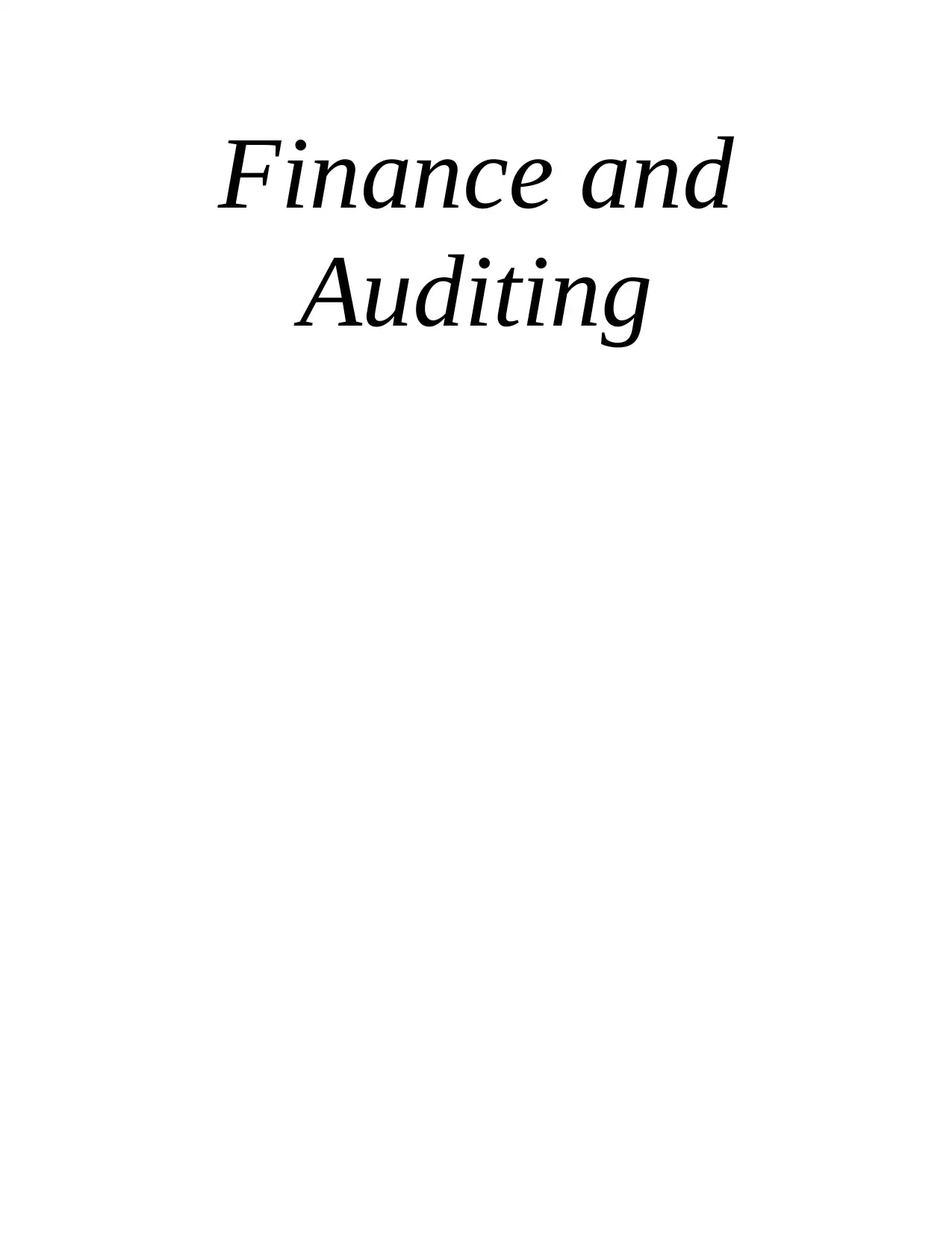
Finance and
Auditing
Auditing
Paraphrase This Document
Need a fresh take? Get an instant paraphrase of this document with our AI Paraphraser

TABLE OF CONTENTS
Introduction......................................................................................................................................3
Task 1...............................................................................................................................................3
1.1 Purpose and use of accounting records..................................................................................3
1.2 Fundamental Accounting Concepts: Importance and Meaning.............................................4
1.3 Factors which influence the nature and structure of accounting systems..............................5
Task 2...............................................................................................................................................6
2.1 Components of Business Risk...............................................................................................6
2.2 The control system in place in a business for the purpose of identification of fraud............7
2.3 Risk of fraud within a business and methods for detection of fraud:....................................8
Task 3...............................................................................................................................................8
3.1 Plan an audit with reference to scope, materiality and risk...................................................8
3.2 Use of appropriate audit tests.................................................................................................9
3.3 Audit process.......................................................................................................................10
Task 4.............................................................................................................................................11
4.1 Auditors' report of manufacturing company:.......................................................................11
4.2 Management report of manufacturing company:.................................................................12
conclusion......................................................................................................................................13
References......................................................................................................................................14
2
Introduction......................................................................................................................................3
Task 1...............................................................................................................................................3
1.1 Purpose and use of accounting records..................................................................................3
1.2 Fundamental Accounting Concepts: Importance and Meaning.............................................4
1.3 Factors which influence the nature and structure of accounting systems..............................5
Task 2...............................................................................................................................................6
2.1 Components of Business Risk...............................................................................................6
2.2 The control system in place in a business for the purpose of identification of fraud............7
2.3 Risk of fraud within a business and methods for detection of fraud:....................................8
Task 3...............................................................................................................................................8
3.1 Plan an audit with reference to scope, materiality and risk...................................................8
3.2 Use of appropriate audit tests.................................................................................................9
3.3 Audit process.......................................................................................................................10
Task 4.............................................................................................................................................11
4.1 Auditors' report of manufacturing company:.......................................................................11
4.2 Management report of manufacturing company:.................................................................12
conclusion......................................................................................................................................13
References......................................................................................................................................14
2
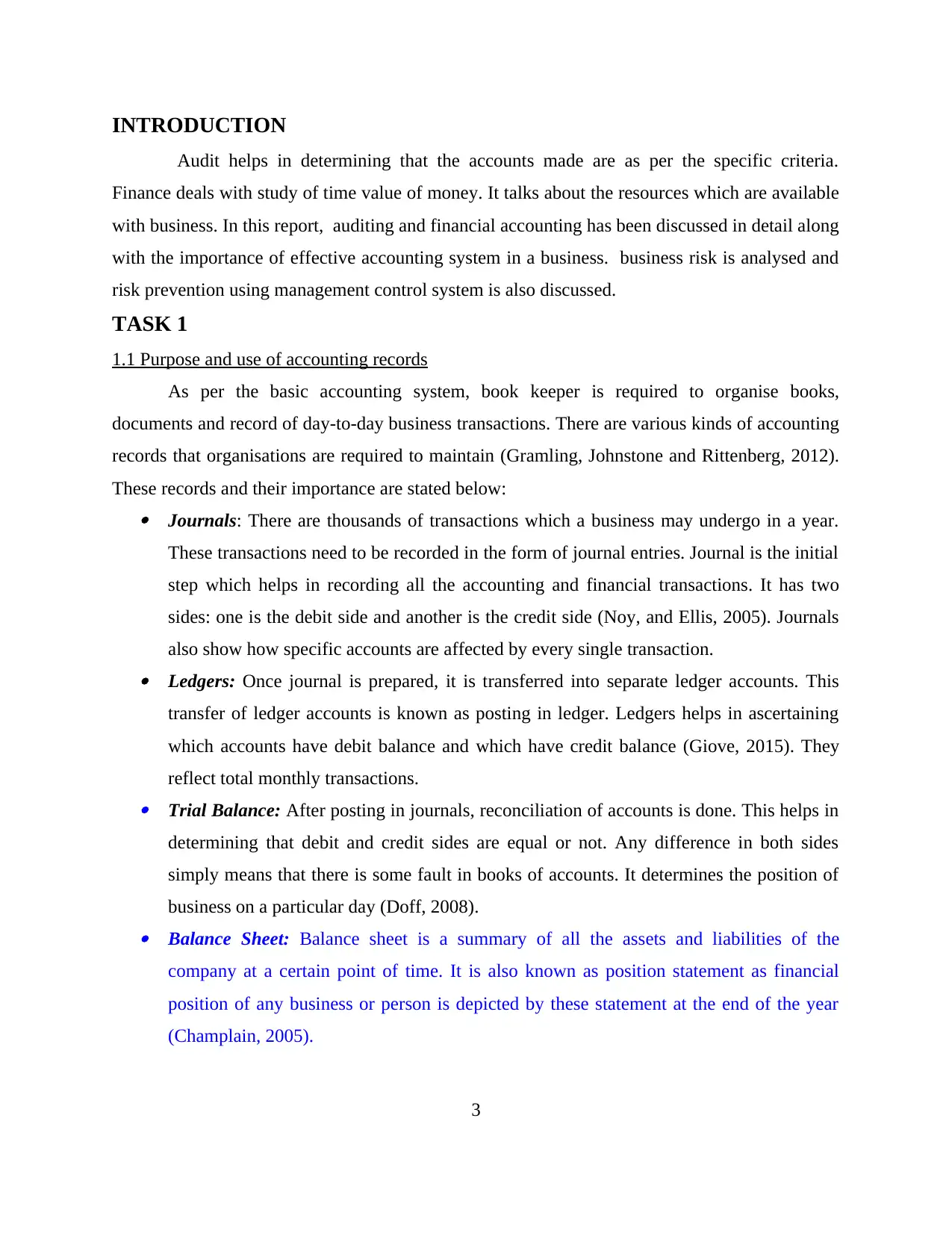
INTRODUCTION
Audit helps in determining that the accounts made are as per the specific criteria.
Finance deals with study of time value of money. It talks about the resources which are available
with business. In this report, auditing and financial accounting has been discussed in detail along
with the importance of effective accounting system in a business. business risk is analysed and
risk prevention using management control system is also discussed.
TASK 1
1.1 Purpose and use of accounting records
As per the basic accounting system, book keeper is required to organise books,
documents and record of day-to-day business transactions. There are various kinds of accounting
records that organisations are required to maintain (Gramling, Johnstone and Rittenberg, 2012).
These records and their importance are stated below: Journals: There are thousands of transactions which a business may undergo in a year.
These transactions need to be recorded in the form of journal entries. Journal is the initial
step which helps in recording all the accounting and financial transactions. It has two
sides: one is the debit side and another is the credit side (Noy, and Ellis, 2005). Journals
also show how specific accounts are affected by every single transaction. Ledgers: Once journal is prepared, it is transferred into separate ledger accounts. This
transfer of ledger accounts is known as posting in ledger. Ledgers helps in ascertaining
which accounts have debit balance and which have credit balance (Giove, 2015). They
reflect total monthly transactions. Trial Balance: After posting in journals, reconciliation of accounts is done. This helps in
determining that debit and credit sides are equal or not. Any difference in both sides
simply means that there is some fault in books of accounts. It determines the position of
business on a particular day (Doff, 2008). Balance Sheet: Balance sheet is a summary of all the assets and liabilities of the
company at a certain point of time. It is also known as position statement as financial
position of any business or person is depicted by these statement at the end of the year
(Champlain, 2005).
3
Audit helps in determining that the accounts made are as per the specific criteria.
Finance deals with study of time value of money. It talks about the resources which are available
with business. In this report, auditing and financial accounting has been discussed in detail along
with the importance of effective accounting system in a business. business risk is analysed and
risk prevention using management control system is also discussed.
TASK 1
1.1 Purpose and use of accounting records
As per the basic accounting system, book keeper is required to organise books,
documents and record of day-to-day business transactions. There are various kinds of accounting
records that organisations are required to maintain (Gramling, Johnstone and Rittenberg, 2012).
These records and their importance are stated below: Journals: There are thousands of transactions which a business may undergo in a year.
These transactions need to be recorded in the form of journal entries. Journal is the initial
step which helps in recording all the accounting and financial transactions. It has two
sides: one is the debit side and another is the credit side (Noy, and Ellis, 2005). Journals
also show how specific accounts are affected by every single transaction. Ledgers: Once journal is prepared, it is transferred into separate ledger accounts. This
transfer of ledger accounts is known as posting in ledger. Ledgers helps in ascertaining
which accounts have debit balance and which have credit balance (Giove, 2015). They
reflect total monthly transactions. Trial Balance: After posting in journals, reconciliation of accounts is done. This helps in
determining that debit and credit sides are equal or not. Any difference in both sides
simply means that there is some fault in books of accounts. It determines the position of
business on a particular day (Doff, 2008). Balance Sheet: Balance sheet is a summary of all the assets and liabilities of the
company at a certain point of time. It is also known as position statement as financial
position of any business or person is depicted by these statement at the end of the year
(Champlain, 2005).
3
⊘ This is a preview!⊘
Do you want full access?
Subscribe today to unlock all pages.

Trusted by 1+ million students worldwide
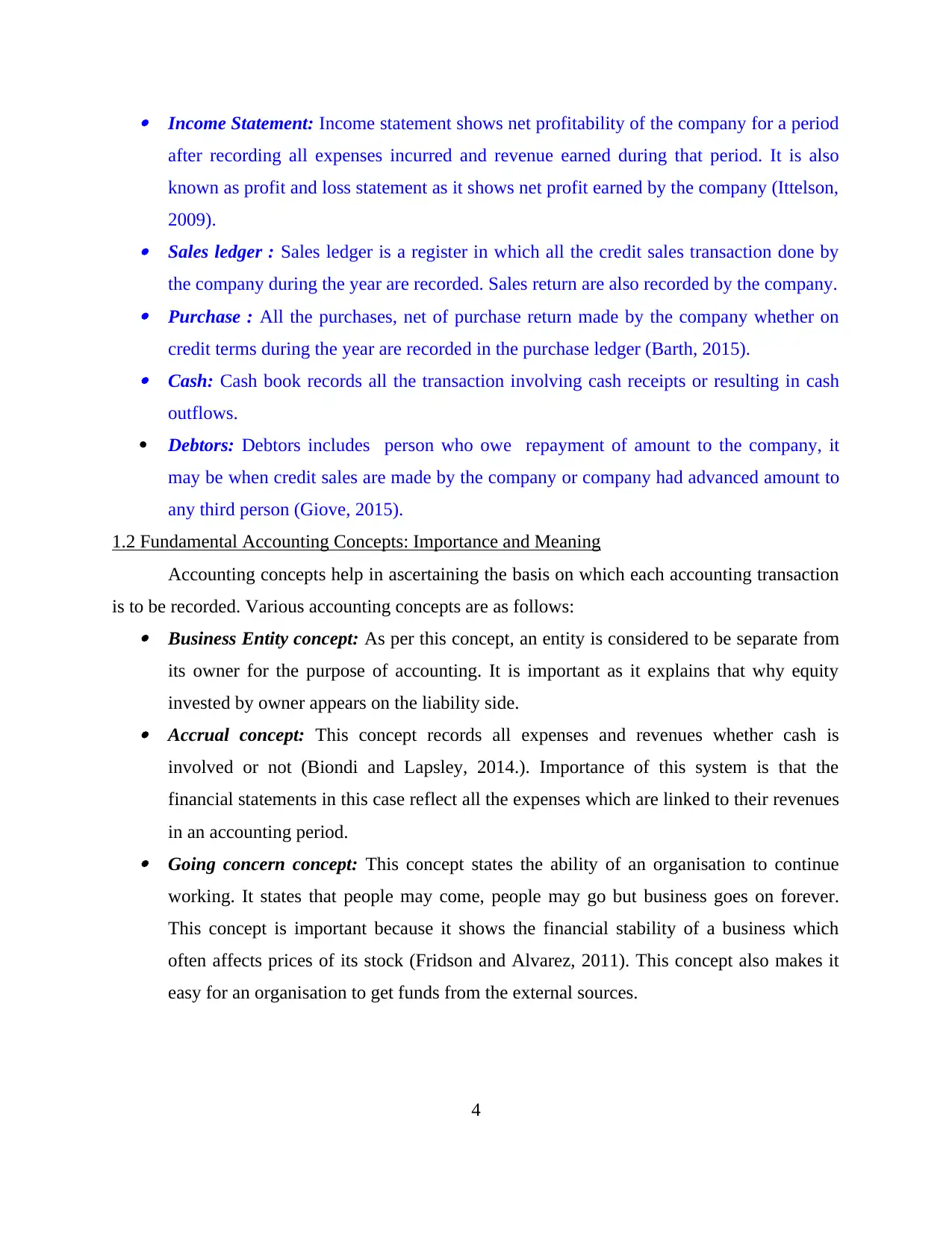
Income Statement: Income statement shows net profitability of the company for a period
after recording all expenses incurred and revenue earned during that period. It is also
known as profit and loss statement as it shows net profit earned by the company (Ittelson,
2009). Sales ledger : Sales ledger is a register in which all the credit sales transaction done by
the company during the year are recorded. Sales return are also recorded by the company. Purchase : All the purchases, net of purchase return made by the company whether on
credit terms during the year are recorded in the purchase ledger (Barth, 2015). Cash: Cash book records all the transaction involving cash receipts or resulting in cash
outflows.
Debtors: Debtors includes person who owe repayment of amount to the company, it
may be when credit sales are made by the company or company had advanced amount to
any third person (Giove, 2015).
1.2 Fundamental Accounting Concepts: Importance and Meaning
Accounting concepts help in ascertaining the basis on which each accounting transaction
is to be recorded. Various accounting concepts are as follows: Business Entity concept: As per this concept, an entity is considered to be separate from
its owner for the purpose of accounting. It is important as it explains that why equity
invested by owner appears on the liability side. Accrual concept: This concept records all expenses and revenues whether cash is
involved or not (Biondi and Lapsley, 2014.). Importance of this system is that the
financial statements in this case reflect all the expenses which are linked to their revenues
in an accounting period. Going concern concept: This concept states the ability of an organisation to continue
working. It states that people may come, people may go but business goes on forever.
This concept is important because it shows the financial stability of a business which
often affects prices of its stock (Fridson and Alvarez, 2011). This concept also makes it
easy for an organisation to get funds from the external sources.
4
after recording all expenses incurred and revenue earned during that period. It is also
known as profit and loss statement as it shows net profit earned by the company (Ittelson,
2009). Sales ledger : Sales ledger is a register in which all the credit sales transaction done by
the company during the year are recorded. Sales return are also recorded by the company. Purchase : All the purchases, net of purchase return made by the company whether on
credit terms during the year are recorded in the purchase ledger (Barth, 2015). Cash: Cash book records all the transaction involving cash receipts or resulting in cash
outflows.
Debtors: Debtors includes person who owe repayment of amount to the company, it
may be when credit sales are made by the company or company had advanced amount to
any third person (Giove, 2015).
1.2 Fundamental Accounting Concepts: Importance and Meaning
Accounting concepts help in ascertaining the basis on which each accounting transaction
is to be recorded. Various accounting concepts are as follows: Business Entity concept: As per this concept, an entity is considered to be separate from
its owner for the purpose of accounting. It is important as it explains that why equity
invested by owner appears on the liability side. Accrual concept: This concept records all expenses and revenues whether cash is
involved or not (Biondi and Lapsley, 2014.). Importance of this system is that the
financial statements in this case reflect all the expenses which are linked to their revenues
in an accounting period. Going concern concept: This concept states the ability of an organisation to continue
working. It states that people may come, people may go but business goes on forever.
This concept is important because it shows the financial stability of a business which
often affects prices of its stock (Fridson and Alvarez, 2011). This concept also makes it
easy for an organisation to get funds from the external sources.
4
Paraphrase This Document
Need a fresh take? Get an instant paraphrase of this document with our AI Paraphraser
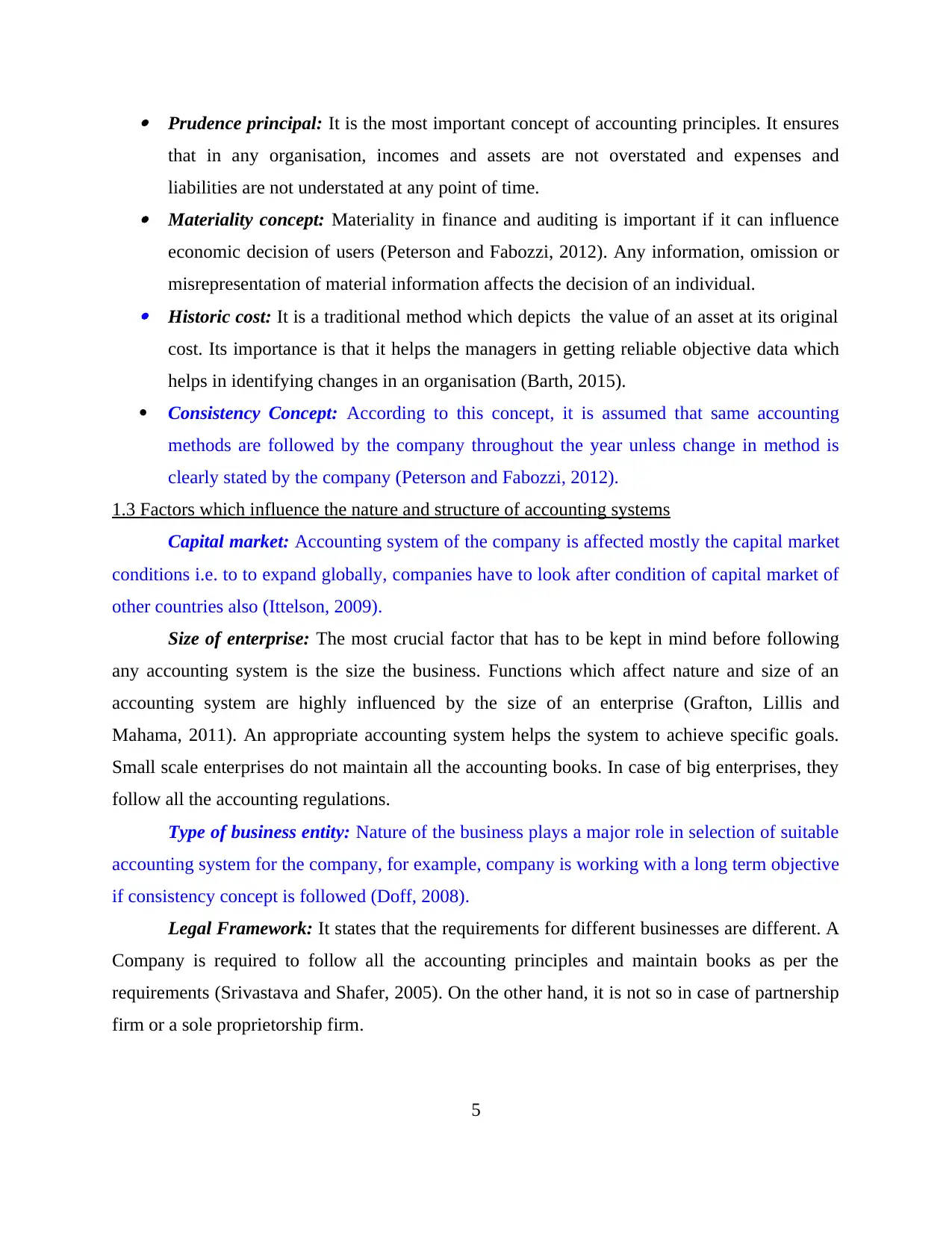
Prudence principal: It is the most important concept of accounting principles. It ensures
that in any organisation, incomes and assets are not overstated and expenses and
liabilities are not understated at any point of time. Materiality concept: Materiality in finance and auditing is important if it can influence
economic decision of users (Peterson and Fabozzi, 2012). Any information, omission or
misrepresentation of material information affects the decision of an individual. Historic cost: It is a traditional method which depicts the value of an asset at its original
cost. Its importance is that it helps the managers in getting reliable objective data which
helps in identifying changes in an organisation (Barth, 2015).
Consistency Concept: According to this concept, it is assumed that same accounting
methods are followed by the company throughout the year unless change in method is
clearly stated by the company (Peterson and Fabozzi, 2012).
1.3 Factors which influence the nature and structure of accounting systems
Capital market: Accounting system of the company is affected mostly the capital market
conditions i.e. to to expand globally, companies have to look after condition of capital market of
other countries also (Ittelson, 2009).
Size of enterprise: The most crucial factor that has to be kept in mind before following
any accounting system is the size the business. Functions which affect nature and size of an
accounting system are highly influenced by the size of an enterprise (Grafton, Lillis and
Mahama, 2011). An appropriate accounting system helps the system to achieve specific goals.
Small scale enterprises do not maintain all the accounting books. In case of big enterprises, they
follow all the accounting regulations.
Type of business entity: Nature of the business plays a major role in selection of suitable
accounting system for the company, for example, company is working with a long term objective
if consistency concept is followed (Doff, 2008).
Legal Framework: It states that the requirements for different businesses are different. A
Company is required to follow all the accounting principles and maintain books as per the
requirements (Srivastava and Shafer, 2005). On the other hand, it is not so in case of partnership
firm or a sole proprietorship firm.
5
that in any organisation, incomes and assets are not overstated and expenses and
liabilities are not understated at any point of time. Materiality concept: Materiality in finance and auditing is important if it can influence
economic decision of users (Peterson and Fabozzi, 2012). Any information, omission or
misrepresentation of material information affects the decision of an individual. Historic cost: It is a traditional method which depicts the value of an asset at its original
cost. Its importance is that it helps the managers in getting reliable objective data which
helps in identifying changes in an organisation (Barth, 2015).
Consistency Concept: According to this concept, it is assumed that same accounting
methods are followed by the company throughout the year unless change in method is
clearly stated by the company (Peterson and Fabozzi, 2012).
1.3 Factors which influence the nature and structure of accounting systems
Capital market: Accounting system of the company is affected mostly the capital market
conditions i.e. to to expand globally, companies have to look after condition of capital market of
other countries also (Ittelson, 2009).
Size of enterprise: The most crucial factor that has to be kept in mind before following
any accounting system is the size the business. Functions which affect nature and size of an
accounting system are highly influenced by the size of an enterprise (Grafton, Lillis and
Mahama, 2011). An appropriate accounting system helps the system to achieve specific goals.
Small scale enterprises do not maintain all the accounting books. In case of big enterprises, they
follow all the accounting regulations.
Type of business entity: Nature of the business plays a major role in selection of suitable
accounting system for the company, for example, company is working with a long term objective
if consistency concept is followed (Doff, 2008).
Legal Framework: It states that the requirements for different businesses are different. A
Company is required to follow all the accounting principles and maintain books as per the
requirements (Srivastava and Shafer, 2005). On the other hand, it is not so in case of partnership
firm or a sole proprietorship firm.
5
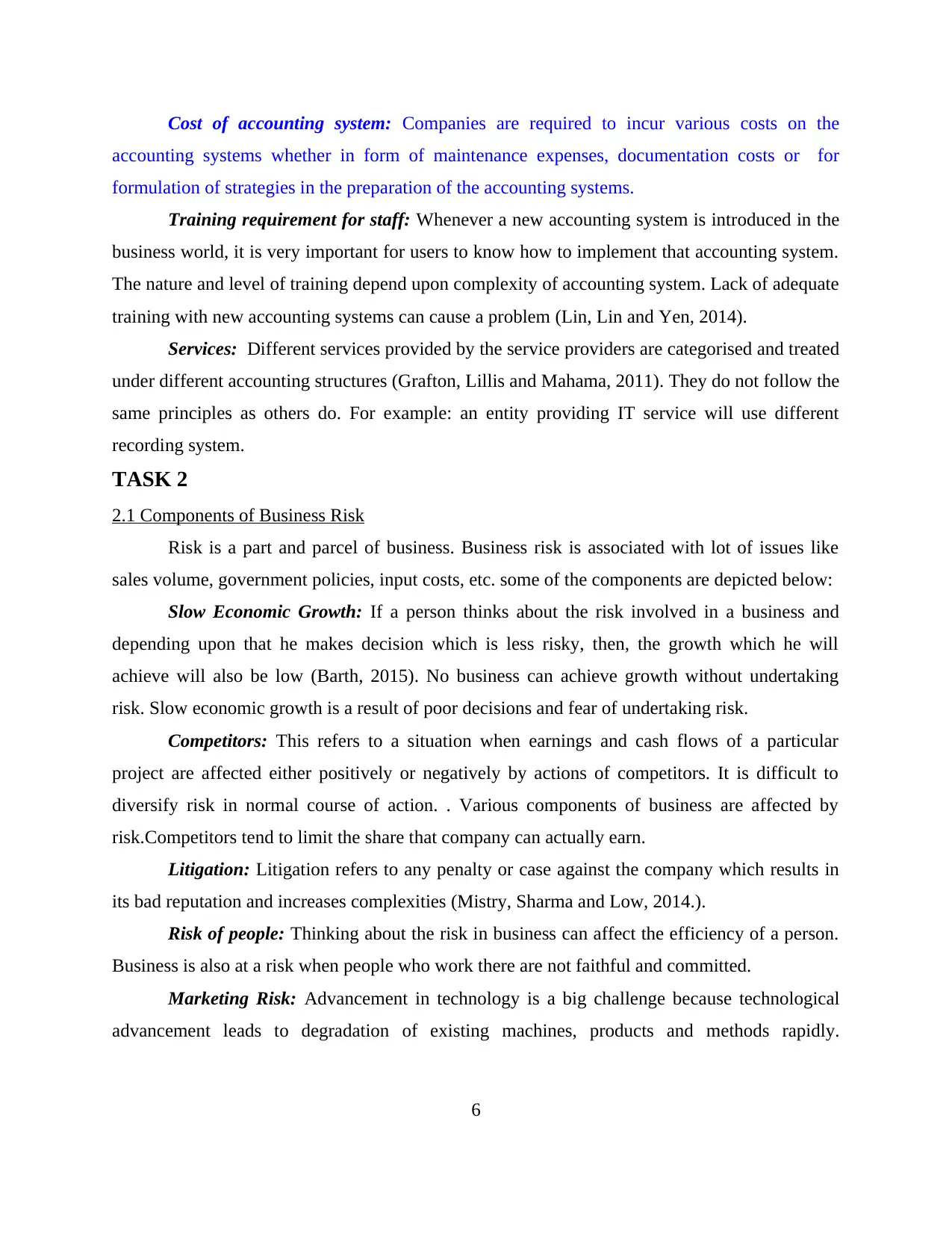
Cost of accounting system: Companies are required to incur various costs on the
accounting systems whether in form of maintenance expenses, documentation costs or for
formulation of strategies in the preparation of the accounting systems.
Training requirement for staff: Whenever a new accounting system is introduced in the
business world, it is very important for users to know how to implement that accounting system.
The nature and level of training depend upon complexity of accounting system. Lack of adequate
training with new accounting systems can cause a problem (Lin, Lin and Yen, 2014).
Services: Different services provided by the service providers are categorised and treated
under different accounting structures (Grafton, Lillis and Mahama, 2011). They do not follow the
same principles as others do. For example: an entity providing IT service will use different
recording system.
TASK 2
2.1 Components of Business Risk
Risk is a part and parcel of business. Business risk is associated with lot of issues like
sales volume, government policies, input costs, etc. some of the components are depicted below:
Slow Economic Growth: If a person thinks about the risk involved in a business and
depending upon that he makes decision which is less risky, then, the growth which he will
achieve will also be low (Barth, 2015). No business can achieve growth without undertaking
risk. Slow economic growth is a result of poor decisions and fear of undertaking risk.
Competitors: This refers to a situation when earnings and cash flows of a particular
project are affected either positively or negatively by actions of competitors. It is difficult to
diversify risk in normal course of action. . Various components of business are affected by
risk.Competitors tend to limit the share that company can actually earn.
Litigation: Litigation refers to any penalty or case against the company which results in
its bad reputation and increases complexities (Mistry, Sharma and Low, 2014.).
Risk of people: Thinking about the risk in business can affect the efficiency of a person.
Business is also at a risk when people who work there are not faithful and committed.
Marketing Risk: Advancement in technology is a big challenge because technological
advancement leads to degradation of existing machines, products and methods rapidly.
6
accounting systems whether in form of maintenance expenses, documentation costs or for
formulation of strategies in the preparation of the accounting systems.
Training requirement for staff: Whenever a new accounting system is introduced in the
business world, it is very important for users to know how to implement that accounting system.
The nature and level of training depend upon complexity of accounting system. Lack of adequate
training with new accounting systems can cause a problem (Lin, Lin and Yen, 2014).
Services: Different services provided by the service providers are categorised and treated
under different accounting structures (Grafton, Lillis and Mahama, 2011). They do not follow the
same principles as others do. For example: an entity providing IT service will use different
recording system.
TASK 2
2.1 Components of Business Risk
Risk is a part and parcel of business. Business risk is associated with lot of issues like
sales volume, government policies, input costs, etc. some of the components are depicted below:
Slow Economic Growth: If a person thinks about the risk involved in a business and
depending upon that he makes decision which is less risky, then, the growth which he will
achieve will also be low (Barth, 2015). No business can achieve growth without undertaking
risk. Slow economic growth is a result of poor decisions and fear of undertaking risk.
Competitors: This refers to a situation when earnings and cash flows of a particular
project are affected either positively or negatively by actions of competitors. It is difficult to
diversify risk in normal course of action. . Various components of business are affected by
risk.Competitors tend to limit the share that company can actually earn.
Litigation: Litigation refers to any penalty or case against the company which results in
its bad reputation and increases complexities (Mistry, Sharma and Low, 2014.).
Risk of people: Thinking about the risk in business can affect the efficiency of a person.
Business is also at a risk when people who work there are not faithful and committed.
Marketing Risk: Advancement in technology is a big challenge because technological
advancement leads to degradation of existing machines, products and methods rapidly.
6
⊘ This is a preview!⊘
Do you want full access?
Subscribe today to unlock all pages.

Trusted by 1+ million students worldwide
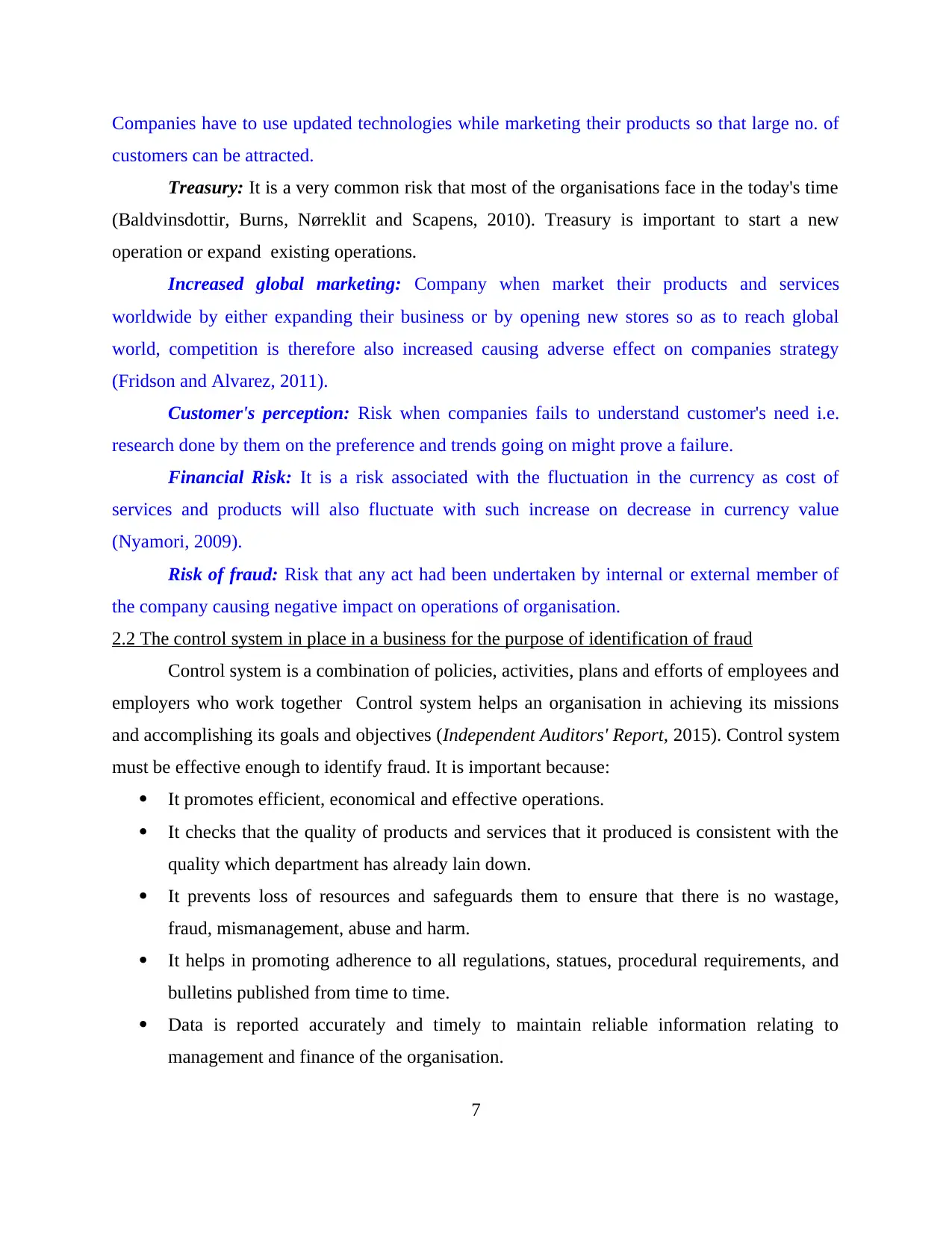
Companies have to use updated technologies while marketing their products so that large no. of
customers can be attracted.
Treasury: It is a very common risk that most of the organisations face in the today's time
(Baldvinsdottir, Burns, Nørreklit and Scapens, 2010). Treasury is important to start a new
operation or expand existing operations.
Increased global marketing: Company when market their products and services
worldwide by either expanding their business or by opening new stores so as to reach global
world, competition is therefore also increased causing adverse effect on companies strategy
(Fridson and Alvarez, 2011).
Customer's perception: Risk when companies fails to understand customer's need i.e.
research done by them on the preference and trends going on might prove a failure.
Financial Risk: It is a risk associated with the fluctuation in the currency as cost of
services and products will also fluctuate with such increase on decrease in currency value
(Nyamori, 2009).
Risk of fraud: Risk that any act had been undertaken by internal or external member of
the company causing negative impact on operations of organisation.
2.2 The control system in place in a business for the purpose of identification of fraud
Control system is a combination of policies, activities, plans and efforts of employees and
employers who work together Control system helps an organisation in achieving its missions
and accomplishing its goals and objectives (Independent Auditors' Report, 2015). Control system
must be effective enough to identify fraud. It is important because:
It promotes efficient, economical and effective operations.
It checks that the quality of products and services that it produced is consistent with the
quality which department has already lain down.
It prevents loss of resources and safeguards them to ensure that there is no wastage,
fraud, mismanagement, abuse and harm.
It helps in promoting adherence to all regulations, statues, procedural requirements, and
bulletins published from time to time.
Data is reported accurately and timely to maintain reliable information relating to
management and finance of the organisation.
7
customers can be attracted.
Treasury: It is a very common risk that most of the organisations face in the today's time
(Baldvinsdottir, Burns, Nørreklit and Scapens, 2010). Treasury is important to start a new
operation or expand existing operations.
Increased global marketing: Company when market their products and services
worldwide by either expanding their business or by opening new stores so as to reach global
world, competition is therefore also increased causing adverse effect on companies strategy
(Fridson and Alvarez, 2011).
Customer's perception: Risk when companies fails to understand customer's need i.e.
research done by them on the preference and trends going on might prove a failure.
Financial Risk: It is a risk associated with the fluctuation in the currency as cost of
services and products will also fluctuate with such increase on decrease in currency value
(Nyamori, 2009).
Risk of fraud: Risk that any act had been undertaken by internal or external member of
the company causing negative impact on operations of organisation.
2.2 The control system in place in a business for the purpose of identification of fraud
Control system is a combination of policies, activities, plans and efforts of employees and
employers who work together Control system helps an organisation in achieving its missions
and accomplishing its goals and objectives (Independent Auditors' Report, 2015). Control system
must be effective enough to identify fraud. It is important because:
It promotes efficient, economical and effective operations.
It checks that the quality of products and services that it produced is consistent with the
quality which department has already lain down.
It prevents loss of resources and safeguards them to ensure that there is no wastage,
fraud, mismanagement, abuse and harm.
It helps in promoting adherence to all regulations, statues, procedural requirements, and
bulletins published from time to time.
Data is reported accurately and timely to maintain reliable information relating to
management and finance of the organisation.
7
Paraphrase This Document
Need a fresh take? Get an instant paraphrase of this document with our AI Paraphraser
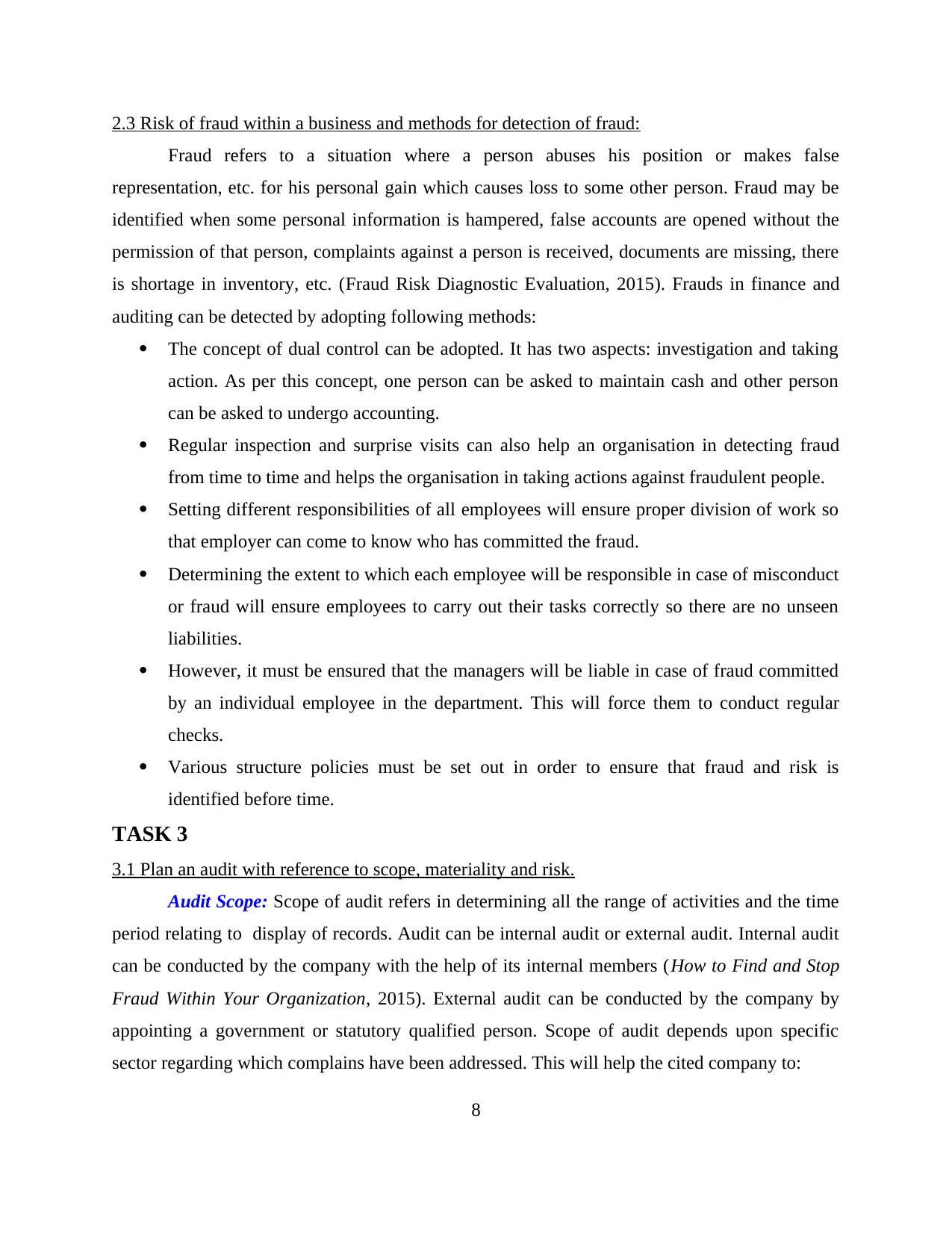
2.3 Risk of fraud within a business and methods for detection of fraud:
Fraud refers to a situation where a person abuses his position or makes false
representation, etc. for his personal gain which causes loss to some other person. Fraud may be
identified when some personal information is hampered, false accounts are opened without the
permission of that person, complaints against a person is received, documents are missing, there
is shortage in inventory, etc. (Fraud Risk Diagnostic Evaluation, 2015). Frauds in finance and
auditing can be detected by adopting following methods:
The concept of dual control can be adopted. It has two aspects: investigation and taking
action. As per this concept, one person can be asked to maintain cash and other person
can be asked to undergo accounting.
Regular inspection and surprise visits can also help an organisation in detecting fraud
from time to time and helps the organisation in taking actions against fraudulent people.
Setting different responsibilities of all employees will ensure proper division of work so
that employer can come to know who has committed the fraud.
Determining the extent to which each employee will be responsible in case of misconduct
or fraud will ensure employees to carry out their tasks correctly so there are no unseen
liabilities.
However, it must be ensured that the managers will be liable in case of fraud committed
by an individual employee in the department. This will force them to conduct regular
checks.
Various structure policies must be set out in order to ensure that fraud and risk is
identified before time.
TASK 3
3.1 Plan an audit with reference to scope, materiality and risk.
Audit Scope: Scope of audit refers in determining all the range of activities and the time
period relating to display of records. Audit can be internal audit or external audit. Internal audit
can be conducted by the company with the help of its internal members (How to Find and Stop
Fraud Within Your Organization, 2015). External audit can be conducted by the company by
appointing a government or statutory qualified person. Scope of audit depends upon specific
sector regarding which complains have been addressed. This will help the cited company to:
8
Fraud refers to a situation where a person abuses his position or makes false
representation, etc. for his personal gain which causes loss to some other person. Fraud may be
identified when some personal information is hampered, false accounts are opened without the
permission of that person, complaints against a person is received, documents are missing, there
is shortage in inventory, etc. (Fraud Risk Diagnostic Evaluation, 2015). Frauds in finance and
auditing can be detected by adopting following methods:
The concept of dual control can be adopted. It has two aspects: investigation and taking
action. As per this concept, one person can be asked to maintain cash and other person
can be asked to undergo accounting.
Regular inspection and surprise visits can also help an organisation in detecting fraud
from time to time and helps the organisation in taking actions against fraudulent people.
Setting different responsibilities of all employees will ensure proper division of work so
that employer can come to know who has committed the fraud.
Determining the extent to which each employee will be responsible in case of misconduct
or fraud will ensure employees to carry out their tasks correctly so there are no unseen
liabilities.
However, it must be ensured that the managers will be liable in case of fraud committed
by an individual employee in the department. This will force them to conduct regular
checks.
Various structure policies must be set out in order to ensure that fraud and risk is
identified before time.
TASK 3
3.1 Plan an audit with reference to scope, materiality and risk.
Audit Scope: Scope of audit refers in determining all the range of activities and the time
period relating to display of records. Audit can be internal audit or external audit. Internal audit
can be conducted by the company with the help of its internal members (How to Find and Stop
Fraud Within Your Organization, 2015). External audit can be conducted by the company by
appointing a government or statutory qualified person. Scope of audit depends upon specific
sector regarding which complains have been addressed. This will help the cited company to:
8

Review the activity for most recent months.
Find out discretionary and restricted expenditures which are not important for the
company.
Review the purchase books correctly and precisely.
Review purchase books with comparison to accounting standards laid down for them.
Determine whether the revenues generated are reasonable and are in control. It will also
ensure proper recording revenues related to purchase department. Ensure effective control of the purchase books.
Materiality: With the help of materiality aspect in audit organisations comes to know
about discrepancies and importance of a transaction (Baldvinsdottir, Burns, Nørreklit and
Scapens, 2010). Purchase books need to be maintained properly to ensure that there is no
omission of facts and misstatement of figures. Any tampering of these purchase records can lead
to big consequences and legal penalties against the company. Thus, true interpretation of these
documents is important.
Audit risk: Audit risk refers to the inability of an auditor to supply qualified and genuine
report. This material misstatement may be due to an error or fraud. These risks are either high
level risks or low level risks or moderate risks. The cited company has a high level of risk in the
purchase department as a result of which the auditing done in that sector will be very stringent
and each single transaction will be monitored very minutely (Fridson and Alvarez, 2011).
However in case of low or moderate risk other accounts of the cited company are maintained
correctly and then they can be monitored with leniency.
3.2 Use of appropriate audit tests
These tests are the procedures that are performed by an auditor for detecting material
misstatements and frauds. For detecting, these following tests can be used by the cited company: Risk assessment procedures: Risk Assessment Procedures help in understanding the
entity, its environment, internal controls, any misstatement in the financials, etc. The
main aim of conducting Risk Assessment Procedures is to understand the internal control
system.
Test of Controls: Here, the auditor’s understanding of internal control helps in
determining risk for each transaction related audit (Nyamori, 2009).
9
Find out discretionary and restricted expenditures which are not important for the
company.
Review the purchase books correctly and precisely.
Review purchase books with comparison to accounting standards laid down for them.
Determine whether the revenues generated are reasonable and are in control. It will also
ensure proper recording revenues related to purchase department. Ensure effective control of the purchase books.
Materiality: With the help of materiality aspect in audit organisations comes to know
about discrepancies and importance of a transaction (Baldvinsdottir, Burns, Nørreklit and
Scapens, 2010). Purchase books need to be maintained properly to ensure that there is no
omission of facts and misstatement of figures. Any tampering of these purchase records can lead
to big consequences and legal penalties against the company. Thus, true interpretation of these
documents is important.
Audit risk: Audit risk refers to the inability of an auditor to supply qualified and genuine
report. This material misstatement may be due to an error or fraud. These risks are either high
level risks or low level risks or moderate risks. The cited company has a high level of risk in the
purchase department as a result of which the auditing done in that sector will be very stringent
and each single transaction will be monitored very minutely (Fridson and Alvarez, 2011).
However in case of low or moderate risk other accounts of the cited company are maintained
correctly and then they can be monitored with leniency.
3.2 Use of appropriate audit tests
These tests are the procedures that are performed by an auditor for detecting material
misstatements and frauds. For detecting, these following tests can be used by the cited company: Risk assessment procedures: Risk Assessment Procedures help in understanding the
entity, its environment, internal controls, any misstatement in the financials, etc. The
main aim of conducting Risk Assessment Procedures is to understand the internal control
system.
Test of Controls: Here, the auditor’s understanding of internal control helps in
determining risk for each transaction related audit (Nyamori, 2009).
9
⊘ This is a preview!⊘
Do you want full access?
Subscribe today to unlock all pages.

Trusted by 1+ million students worldwide

Substantive tests of Transactions: These tests are procedures that have been designed to
test misstatements which affect the correctness of balances of financial statements. It
determines whether all the six audit objectives have been satisfied for each transaction or
not. Analytical Procedures: Analytical Procedures help in comparing expectations of the
auditor with that of the recorded amounts. It must be done in advance at the time of
planning (Barth, 2015). The key feature and function of analytical procedures is to
indicate all possible misstatements and to provide reasonable evidence.
Tests of Details of Balances: The test mainly focuses on balancing ledger accounts in
balance sheet and income statement. It establishes monetary correctness in the financials.
The extension of this test wholly depends upon results of test of control, substantive test
of transactions and substantive analytical procedures.
3.3 Audit process1. Demanding necessary documents: This states the key area in which internal audit is
required to be conducted. The cited company must identify its business process and
understand the need of audit data (Giove, 2015). Auditing team should demand sources
of data and information from the company on the basis of which audit will be conducted.2. Identifying monitoring and continuous audit rules: This refers to a situation when
accounts and books are checked all the year round to comply with the standards.3. Determining the process' frequency: It helps in determining the company that how
frequently it needs to monitor and start the auditing process.4. Audit planning: Before implementing continuous audit, it is necessary for the company
to set rules and standards for conducting the audit (Srivastava and Shafer, 2005). Various
plans and policies are formed by adopting different accounting methods in order to
conduct audit in a proper manner.
5. Reporting and follow up: This helps in detecting errors and setting alarms in case of
fraud. Further, it also helps in improving the financial status of a company.
6. Final Report: The final outcome of any process is the result that needs to be
communicated (Grafton, Lillis and Mahama, 2011). A final report is prepared by the
auditor forming an opinion on the financial statements of the company. Internal audit
10
test misstatements which affect the correctness of balances of financial statements. It
determines whether all the six audit objectives have been satisfied for each transaction or
not. Analytical Procedures: Analytical Procedures help in comparing expectations of the
auditor with that of the recorded amounts. It must be done in advance at the time of
planning (Barth, 2015). The key feature and function of analytical procedures is to
indicate all possible misstatements and to provide reasonable evidence.
Tests of Details of Balances: The test mainly focuses on balancing ledger accounts in
balance sheet and income statement. It establishes monetary correctness in the financials.
The extension of this test wholly depends upon results of test of control, substantive test
of transactions and substantive analytical procedures.
3.3 Audit process1. Demanding necessary documents: This states the key area in which internal audit is
required to be conducted. The cited company must identify its business process and
understand the need of audit data (Giove, 2015). Auditing team should demand sources
of data and information from the company on the basis of which audit will be conducted.2. Identifying monitoring and continuous audit rules: This refers to a situation when
accounts and books are checked all the year round to comply with the standards.3. Determining the process' frequency: It helps in determining the company that how
frequently it needs to monitor and start the auditing process.4. Audit planning: Before implementing continuous audit, it is necessary for the company
to set rules and standards for conducting the audit (Srivastava and Shafer, 2005). Various
plans and policies are formed by adopting different accounting methods in order to
conduct audit in a proper manner.
5. Reporting and follow up: This helps in detecting errors and setting alarms in case of
fraud. Further, it also helps in improving the financial status of a company.
6. Final Report: The final outcome of any process is the result that needs to be
communicated (Grafton, Lillis and Mahama, 2011). A final report is prepared by the
auditor forming an opinion on the financial statements of the company. Internal audit
10
Paraphrase This Document
Need a fresh take? Get an instant paraphrase of this document with our AI Paraphraser

report shows that all the accounts and financial information is maintained according to
the accounting standards.
TASK 4
4.1 Auditors' report of manufacturing company:
AUDITOR'S REPORT
NAME OF THE AUDITOR:
DATE :
NAME OF THE FIRM :
EXECUTIVE SUMMARY: Audit of manufacturing company has been conducted. The purpose
of this audit was to assess the process of reviewing and maintaining accounting standards. It is
found that all the accounts, except purchase account are properly maintained. All the accounting
policies and procedures have been followed. Data reported is accurate and it includes all the
standards. The audit was completed in November 2015. For conducting audit a wide range of
activities were carried out and the results of audit helped the department in improving processes
which involved accounting standards.
SCOPE OF AUDIT: Internal audit of the organisation has been done and certified information
has been provided. It helps the auditor in determining the reason for carrying out audit. Audit
report is reliable and information which is provided are :
Evaluated and mistakes have been rectified.
Assessed and changes have been recorded.
Verified and report is according to the accounting standards.
OPINION OF AUDITOR: In the opinion of Auditor, the governance, internal control, risk
management, and accounting standards were determined to be acceptable. However, there were
weaknesses found with purchase account at the time of reviewing accounting standards and the
methods adopted to maintain the purchase account. The financials gave a true and fair view in
accordance with financial reporting framework which is used in preparing presentation of
financial statements.
NAME OF SENIOR EXECUTIVE OFFICER:
11
the accounting standards.
TASK 4
4.1 Auditors' report of manufacturing company:
AUDITOR'S REPORT
NAME OF THE AUDITOR:
DATE :
NAME OF THE FIRM :
EXECUTIVE SUMMARY: Audit of manufacturing company has been conducted. The purpose
of this audit was to assess the process of reviewing and maintaining accounting standards. It is
found that all the accounts, except purchase account are properly maintained. All the accounting
policies and procedures have been followed. Data reported is accurate and it includes all the
standards. The audit was completed in November 2015. For conducting audit a wide range of
activities were carried out and the results of audit helped the department in improving processes
which involved accounting standards.
SCOPE OF AUDIT: Internal audit of the organisation has been done and certified information
has been provided. It helps the auditor in determining the reason for carrying out audit. Audit
report is reliable and information which is provided are :
Evaluated and mistakes have been rectified.
Assessed and changes have been recorded.
Verified and report is according to the accounting standards.
OPINION OF AUDITOR: In the opinion of Auditor, the governance, internal control, risk
management, and accounting standards were determined to be acceptable. However, there were
weaknesses found with purchase account at the time of reviewing accounting standards and the
methods adopted to maintain the purchase account. The financials gave a true and fair view in
accordance with financial reporting framework which is used in preparing presentation of
financial statements.
NAME OF SENIOR EXECUTIVE OFFICER:
11
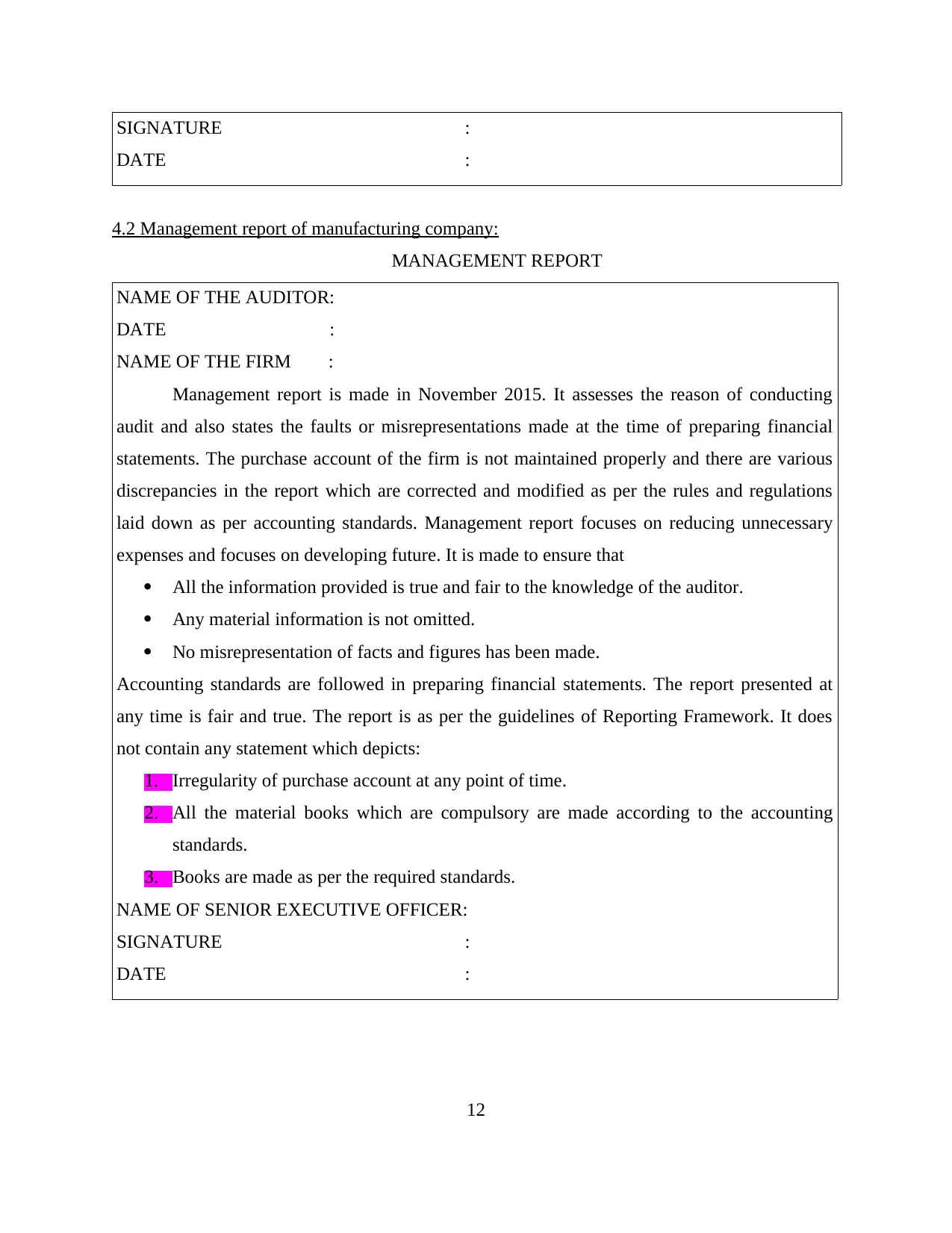
SIGNATURE :
DATE :
4.2 Management report of manufacturing company:
MANAGEMENT REPORT
NAME OF THE AUDITOR:
DATE :
NAME OF THE FIRM :
Management report is made in November 2015. It assesses the reason of conducting
audit and also states the faults or misrepresentations made at the time of preparing financial
statements. The purchase account of the firm is not maintained properly and there are various
discrepancies in the report which are corrected and modified as per the rules and regulations
laid down as per accounting standards. Management report focuses on reducing unnecessary
expenses and focuses on developing future. It is made to ensure that
All the information provided is true and fair to the knowledge of the auditor.
Any material information is not omitted.
No misrepresentation of facts and figures has been made.
Accounting standards are followed in preparing financial statements. The report presented at
any time is fair and true. The report is as per the guidelines of Reporting Framework. It does
not contain any statement which depicts:
1. Irregularity of purchase account at any point of time.
2. All the material books which are compulsory are made according to the accounting
standards.
3. Books are made as per the required standards.
NAME OF SENIOR EXECUTIVE OFFICER:
SIGNATURE :
DATE :
12
DATE :
4.2 Management report of manufacturing company:
MANAGEMENT REPORT
NAME OF THE AUDITOR:
DATE :
NAME OF THE FIRM :
Management report is made in November 2015. It assesses the reason of conducting
audit and also states the faults or misrepresentations made at the time of preparing financial
statements. The purchase account of the firm is not maintained properly and there are various
discrepancies in the report which are corrected and modified as per the rules and regulations
laid down as per accounting standards. Management report focuses on reducing unnecessary
expenses and focuses on developing future. It is made to ensure that
All the information provided is true and fair to the knowledge of the auditor.
Any material information is not omitted.
No misrepresentation of facts and figures has been made.
Accounting standards are followed in preparing financial statements. The report presented at
any time is fair and true. The report is as per the guidelines of Reporting Framework. It does
not contain any statement which depicts:
1. Irregularity of purchase account at any point of time.
2. All the material books which are compulsory are made according to the accounting
standards.
3. Books are made as per the required standards.
NAME OF SENIOR EXECUTIVE OFFICER:
SIGNATURE :
DATE :
12
⊘ This is a preview!⊘
Do you want full access?
Subscribe today to unlock all pages.

Trusted by 1+ million students worldwide
1 out of 15
Related Documents
Your All-in-One AI-Powered Toolkit for Academic Success.
+13062052269
info@desklib.com
Available 24*7 on WhatsApp / Email
![[object Object]](/_next/static/media/star-bottom.7253800d.svg)
Unlock your academic potential
Copyright © 2020–2025 A2Z Services. All Rights Reserved. Developed and managed by ZUCOL.





